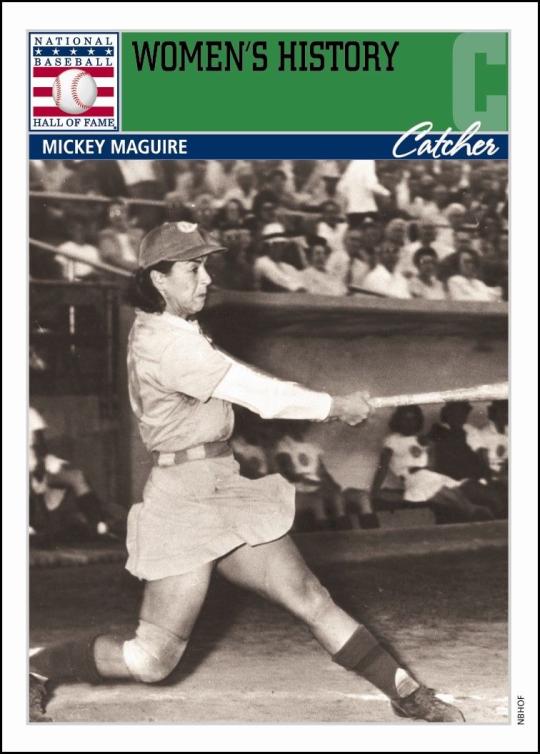Lesson 2: Women's History (Advanced)
Lesson
1. Begin the lesson with a discussion about women's baseball history. Use the following questions to help determine students’ familiarity with the topic:
• Have you ever heard of women or girls playing baseball today? In the past?
• Have you ever heard of any women's baseball teams?
2. Discuss that for modern women who want to play baseball, there are several different options: playing on all-female baseball teams, playing on otherwise all-male teams, or playing softball. While women-only baseball clubs first appeared in the 1800s, the trend was most popular during World War II.
3. Briefly discuss how World War II influenced the experiences of many American women. Mind map what the students already know about women’s roles during World War II. Students should understand that women were called on to fill many roles on the home front to help meet war needs.
4. Explain that new roles and opportunities for women applied not only to the world of work, but also to the world of sports. Explain that students will be examining sources related to the All-American Girls Professional Baseball League.
5. Review the differences between primary and secondary sources.
6. Provide each student with an “All-American Girls Document Packet” (included). Have students read each of the documents and answer the questions on each page.
7. After students have had time to review the document packets and answer the questions, come back together as a class and discuss the following questions:
• Who formed the AAGPBL? Why?
• Describe the average AAGPBL player using as much detail as possible.
• When did the league operate? Construct a timeline of AAGPBL history from its inception to its close.
• Discuss evidence of bias in the sources. What can be determined about expectations of women during the 1940s and 1950s?
8. Introduce the activity.
Activity
1. Introduce the film A League of Their Own, about the All-American Girls Professional Baseball League. You may choose to show select scenes or watch the whole movie if time allows.
2. Hold an informal post-viewing conversation. Use the following questions to help guide discussion:
• How does the AAGPBL as portrayed in the movie compare to the real AAGPBL students read about in the document packet?
• What additional questions does the movie raise?
• How would you go about finding answers to those questions? (Brainstorm a list of potential sources.)
Conclusion:
To conclude this lesson and check for understanding have students select one of the following essay topics. Students should answer their chosen question referencing evidence from the primary and secondary sources, as well as the film watched in class.
• The AAGPBL is an excellent historical example of a profitable and popular women’s professional sports league. For the league to succeed, however, the idea of a female athlete had to be acceptable to the public. How did the media coverage and promotion of the league reveal gender ideals of the time?
• Like many women on the home front during World War II, AAGPBL players had to negotiate their changing role in society. How did the AAGBPL players both challenge and reinforce women’s roles?
Common Core Standards
RI.9-10.7. Analyze various accounts of a subject told in different mediums (e.g., a person’s life story in both print and multimedia), determining which details are emphasized in each account.
RI.11-12.7. Integrate and evaluate multiple sources of information presented in different media or formats (e.g., visually, quantitatively) as well as in words in order to address a question or solve a problem.
W.9-10.1., W.11-12.1. Write arguments to support claims in an analysis of substantive topics or texts, using valid reasoning and relevant and sufficient evidence.
W.9-10.2., W.11-12.2. Write informative/explanatory texts to examine and convey complex ideas, concepts, and information clearly and accurately through the effective selection, organization, and analysis of content.
W.9-10.4., W.11-12.2. Produce clear and coherent writing in which the development, organization, and style are appropriate to task, purpose, and audience.
RH.9-10.1., RH.11-12.1. Cite specific textual evidence to support analysis of primary and secondary sources, attending to such features as the date and origin of the information.
RH.9-10.4., RH.11-12.4. Determine the meaning of words and phrases as they are used in a text, including vocabulary describing political, social, or economic aspects of history/social science.
RH.9-10.6., RH.11-12.6. Compare the point of view of two or more authors for how they treat the same or similar topics, including which details they include and emphasize in their respective accounts.
RH.9-10.9., RH.11-12.9. Compare and contrast treatments of the same topic in several primary and secondary sources.

